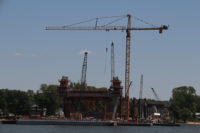Nonresidential building, at $131.6 billion (annual rate), decreased 4% in October. The manufacturing plant category plunged 73%, continuing to pull back from the improved activity that was reported earlier in 2012. Murray noted, “As the result of the uncertainty created by the looming fiscal cliff, manufacturers have increasingly held back on investment as 2012 has progressed.” Warehouse construction also weakened substantially in October, falling 33%.
Office construction in October slipped 3%, although the month did include the start of several noteworthy projects—the $216-million Tower at PNC Plaza in Pittsburgh, the $110-million Energy Center III office tower in Houston, a $76-million municipal office building in Boston, and a $50-million corporate headquarters renovation for TJX in Marlborough, Mass. On the plus side, hotel construction in October grew 7%, helped by the start of a $189-million hotel in Austin. Store construction also registered a gain in October, rising 3% with the help of the $101-million retail portion of the $250-million City Point Residential Retail Development Project (Phase 2) in Brooklyn, N.Y.
On the institutional side, the educational facilities category continued to lose momentum, dropping 3%. Even with the decline, several large education projects reached groundbreaking in October, including a $95-million facility for the University of Tennessee in Knoxville, Tenn., as well as two large high school projects in Massachusetts.
More considerable October declines were registered by amusement-related projects, down 22%; and transportation terminals, down 50%.
The public buildings category posted a large October gain, climbing 92% due to the start of a $524-million military facility at Offutt Air Force Base in Nebraska. Health-care facilities also registered a large October gain, advancing 37% with the help of five hospital projects valued each in excess of $100 million. These hospital projects were located in Virginia ($215 million), Iowa ($150 million), Florida ($111 million), North Carolina ($104 million) and Ohio ($102 million). Church construction in October edged up 1%, although the level of activity for this project type continues to be very depressed.
Residential Building
Residential building in October dropped 2% to $169.9 billion (annual rate). The downward pull came from multifamily housing, which retreated 7% from September. During 2012, multifamily housing has fluctuated around an upward trend, and the pace for multifamily housing in October was still 23% above the level reported at the start of the year. Large multifamily projects that reached groundbreaking in October included the $200-million Insignia Residential Towers in Seattle and $149 million for the multifamily portion of the City Point project in Brooklyn, N.Y.
Single-family housing in October was unchanged from September, maintaining the enhanced activity that’s been established over the course of 2012. The October single-family amount was up 25% from the level reported at the start of the year, and this project type had earlier shown gains in seven out of the nine preceding months. During the January-October period of 2012, the regional pattern for single-family housing showed the largest increase in the West, up 39%; followed by the Midwest, up 28%; the South Atlantic, up 26%; the South Central, up 22%; and the Northeast, up 14%.
The 4% pickup for total construction on an unadjusted basis during the first 10 months of 2012 was the result of increases for two of the three main construction groups. Residential building advanced 28%, with year-to-date gains of 27% for single-family housing and 30% for multifamily housing. Nonbuilding construction grew 3% year-to-date, the result of combining an 11% increase for the electric utility and gas plant category and “no change” for public works. Nonresidential building continued to be the one major construction group to register a year-to-date decline, falling 14%. The nonresidential building decline was due to this behavior by segment—commercial building, up 2%; institutional building, down 15%; and manufacturing building, down 47%.
To a large extent, the nonresidential building decline in dollar terms comes from the comparison to several massive projects that reached groundbreaking during the first 10 months of 2011, including a $3-billion coal-to-gasoline plant in West Virginia, a $1.5-billion semiconductor plant in Arizona, a $1.2-billion airport terminal in New York, and a $1.1-billion government data center in Utah.
On a square footage basis, nonresidential building in the first 10 months of 2012 was up 1% compared to a year ago.
By geography, total construction starts during the January-October period of 2012 showed a large gain for the South Atlantic, up 24%, with much of the upward push coming from the start of two massive nuclear power projects in Georgia and South Carolina. If these two projects are excluded, then total construction starts in the South Atlantic would be up only 1%. Year-to-date gains for total construction were also reported for the Midwest, up 6%; and the South Central, up 5%. Year-to-date declines for total construction were reported for the Northeast, down 6%; and the West, down 8%.


Post a comment to this article
Report Abusive Comment